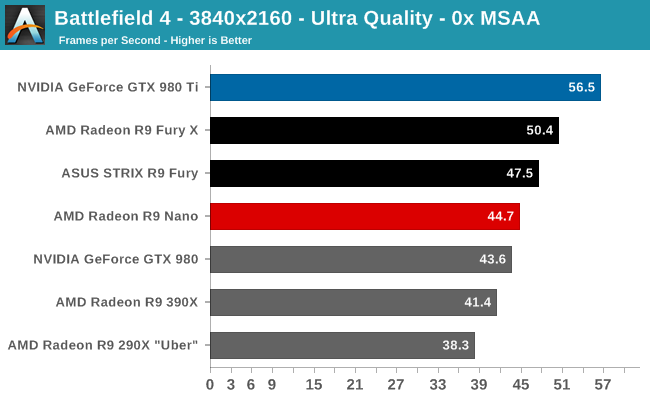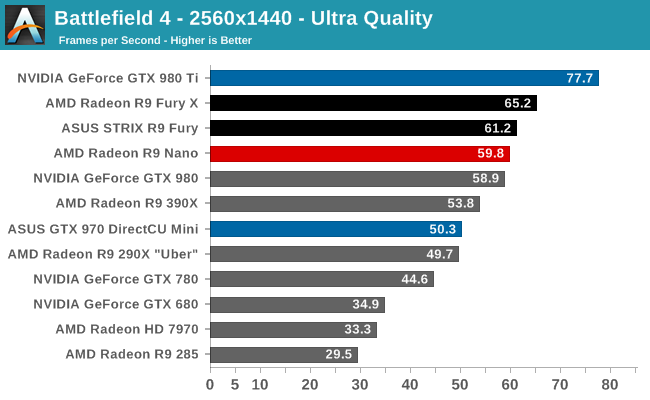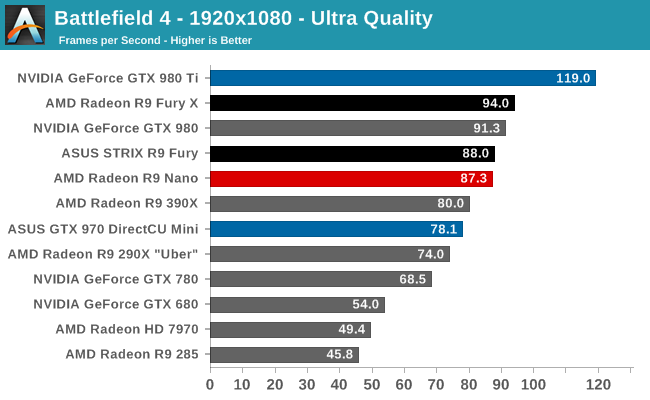The AMD Radeon R9 Nano Review: The Power of Size
by Ryan Smith on September 10, 2015 8:00 AM ESTBattlefield 4
Kicking off our benchmark suite is Battlefield 4, DICE’s 2013 multiplayer military shooter. After a rocky start, Battlefield 4 has since become a challenging game in its own right and a showcase title for low-level graphics APIs. As these benchmarks are from single player mode, based on our experiences our rule of thumb here is that multiplayer framerates will dip to half our single player framerates, which means a card needs to be able to average at least 60fps if it’s to be able to hold up in multiplayer.




Like the other Fiji cards, AMD is promoting the R9 Nano in part on its 4K capabilities. And while we disagree that this card is suitable for 4K gaming based on its sub-Fury performance, we’re including 4K results anyhow to serve as a point of comparison.
In any case Battlefield 4 is often a good indicator of general card performance, and for the R9 Nano this is no exception. What we find is that the R9 Nano trails the other Fury cards in all cases. However to our initial surprise, the R9 Nano sticks rather close to the R9 Fury. The petite powerhouse trails the R9 Fury by only 1-6%, which for the record is a smaller gap than we were expecting.
While the R9 Nano packs a full Fiji GPU, AMD has to pull back on clockspeeds to hit their power targets; in the case of Battlefield 4 this is an average clockspeed of just 879MHz at 2560x1440. Given this we had been expecting the R9 Nano to deliver around 85-90% of the performance of the R9 Fury (and about 80% of the R9 Fury X), based on the assumption that average clockspeeds would be closer to 800MHz. So the fact that the R9 Nano starts off as close to the R9 Fury as it does – even if it’s still trailing it – is a pleasant surprise.
Otherwise with performance still clearly occupying a position as a “3rd tier” Fiji card, I’m not sure if anything about these results should be surprising. On a price/performance basis AMD is not intending to be competitive with other $650 cards, so the R9 Fury X and GTX 980 Ti are of course on the top of the heap. What you get instead is a card that delivers around 90% of R9 Fury X’s performance in BF4 with much less power consumption.
Moving on, compared to the lower power and smaller cards, the R9 Nano is as expected a clean sweep. Demonstrating the virtues of a wide and lower clocked processor’s ability to deliver strong performance without requiring extreme power, everything from the R9 285 to the GTX 980 trails the R9 Nano here. Compared to the GTX 970 Mini in particular, the R9 Nano is 12-26% faster depending on the resolution.
The one potential problem here for the R9 Nano is the GTX 980. Though not a Mini-ITX card, the GTX 980’s power consumption is going to be fairly close to the R9 Nano’s, definitely more so than GTX 970’s. From a power efficiency standpoint it’s the GTX 980 that poses the greatest challenge to the R9 Nano, and while it’s ahead of the GTX 980 in this case at 2560x1440 and higher, it’s a sign that AMD should be worried about what could happen if an NVIDIA partner produced a Mini-ITX GTX 980.










284 Comments
View All Comments
Drumsticks - Thursday, September 10, 2015 - link
??? I never said I was going to buy the Nano. You just said exactly what my plan was, to buy a GPU when 16nm FF hits. I'm still chugging along with 1080p and a 7850, but I'll probably be grabbing QuadHD or 4K next year with a big GPU upgrade.That doesn't mean that looking at potential DX12 performance now won't give a hint of what's to come, though. AMD stands to gain a lot from dx12 from what we've seen.
mosu - Thursday, September 10, 2015 - link
With a 16nm FinFet you'll get Nvidia, a 14nm FinFET will come from Glo-Foundries, so you'll get something from AMD.extide - Thursday, September 10, 2015 - link
It's NOT a lack of ROP's guys, its a lack of geometry bhardware. Check out the pixel fill rate tests, that does NOT indicate a lack of ROP's. This car beats the 980 at high res, but not low res, thats NOT a ROP issue, that's either driver overheard and/or geometry issue.silverblue - Friday, September 11, 2015 - link
I wonder if AMD has ever responded to the issue of driver overhead. If not, they should. It's a massacre at lower resolutions and detail levels at times.jardows2 - Thursday, September 10, 2015 - link
I do not see any enthusiast buying this card for their own build. Where I do see this card selling is in boutique systems sold for a combination of style and performance. In a tiny system targeted for 1440 gaming, which I think should be the focus rather than 4k, this would do great!MrSpadge - Thursday, September 10, 2015 - link
That voltage-frequency curve looks horrible! From the average clocks speeds we know the card is mostly running between 800 and 900 MHz. Yet on that plot we see no power states defined between 0.93 V and 1.04 V. Yet that's where the card would need to operate between 750 and 850 MHz. Why is AMD limiting their power efficiency by providing too few power states? Or is it simply a matter of measuring the low voltages correctly?teiresias - Thursday, September 10, 2015 - link
What were the terms Anandtech agreed to with Roy Taylor in order to secure this Nano sample? I honestly can't take any review of this product seriously unless the editorials of each site come out with statements on what their agreements with AMD were concerning review content.Ryan Smith - Thursday, September 10, 2015 - link
"What were the terms Anandtech agreed to with Roy Taylor in order to secure this Nano sample?"For the record I didn't need to agree to any terms. Nor have I conversed with Roy in quite some time.
jtrdfw - Thursday, September 10, 2015 - link
Thats good.Wreckage - Thursday, September 10, 2015 - link
If they agreed to anything it would probably be covered under a "non disclosure agreement" so legally they would not be able to say anything. Such an agreement would come from AMD marketing, not from Roy directly. I assume there was some sort of reviewers guide they wanted people to follow. How strictly any site followed that guide or why certain sites were deemed "fair" by AMD will most likely remain speculation